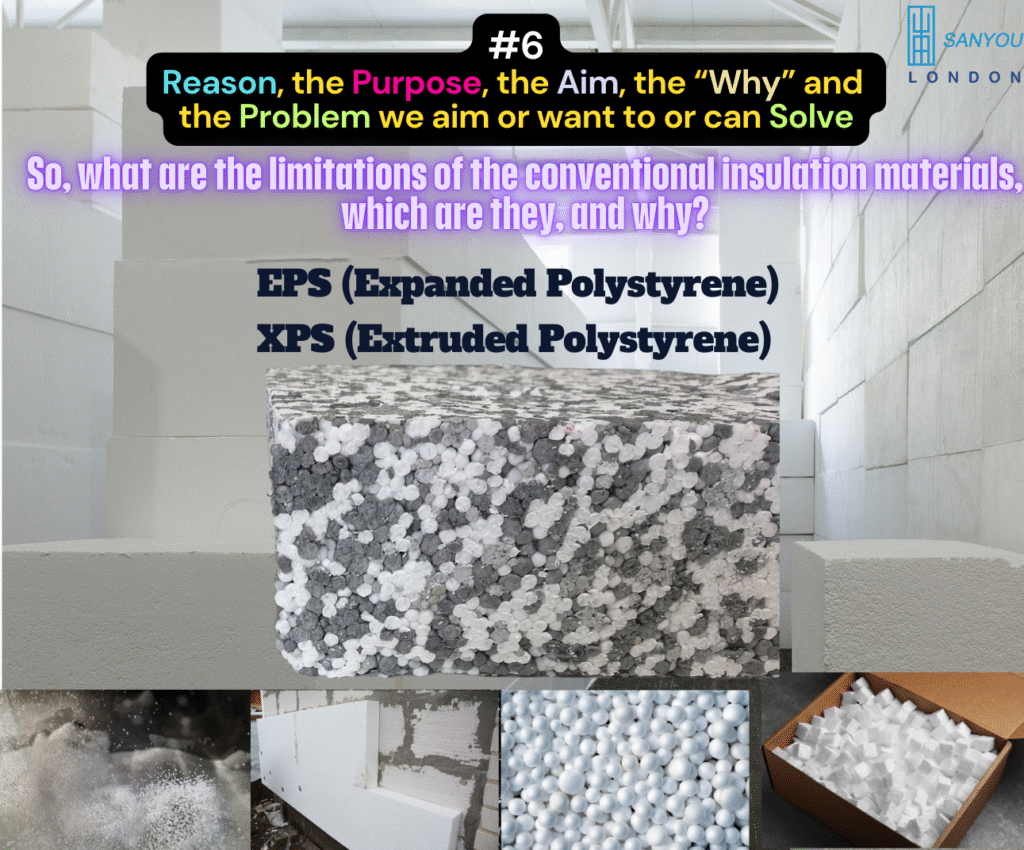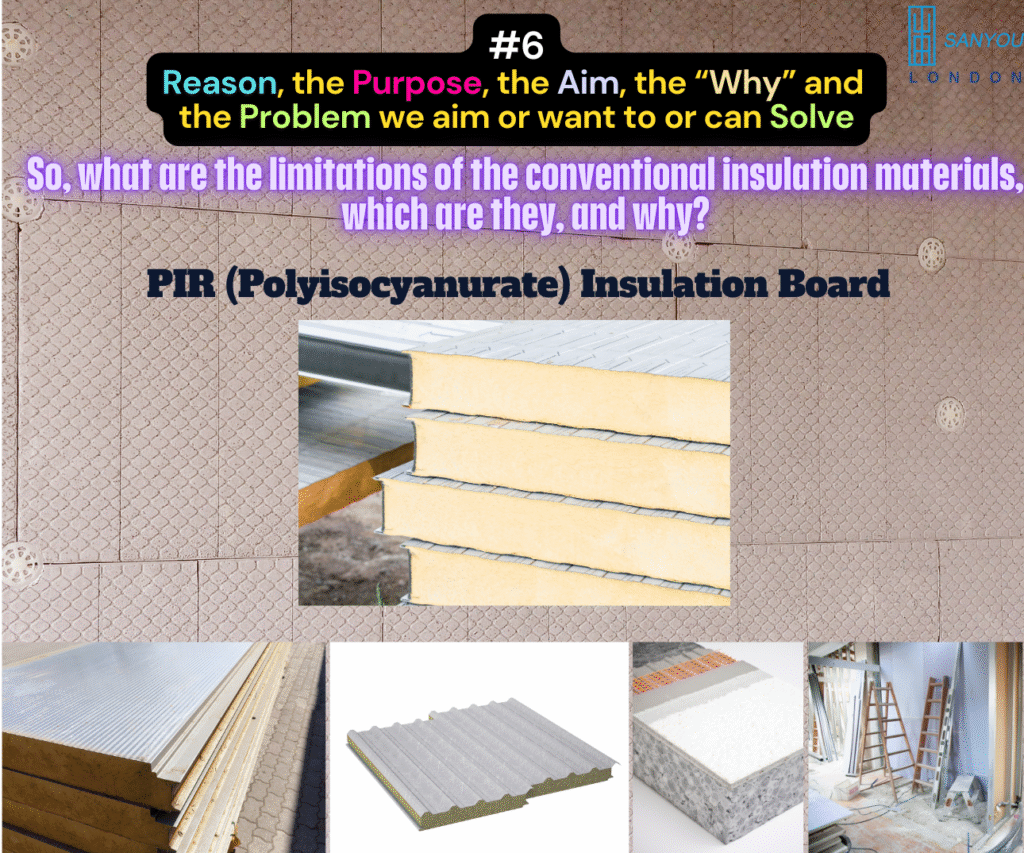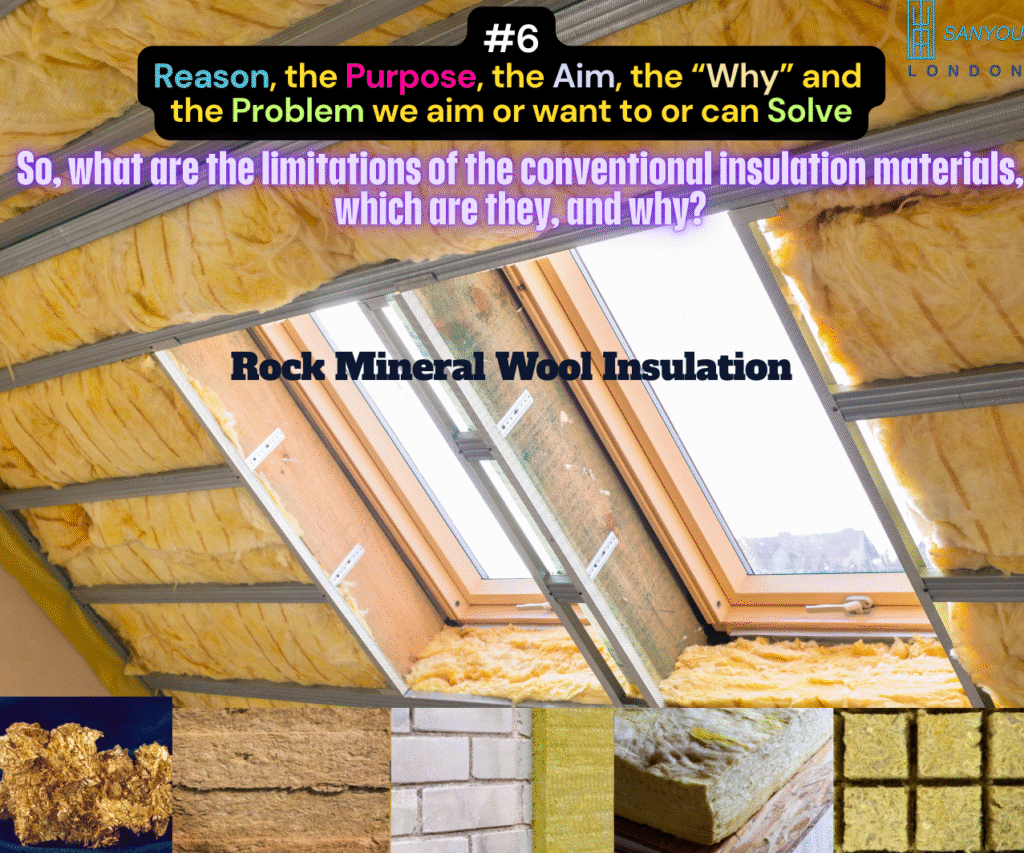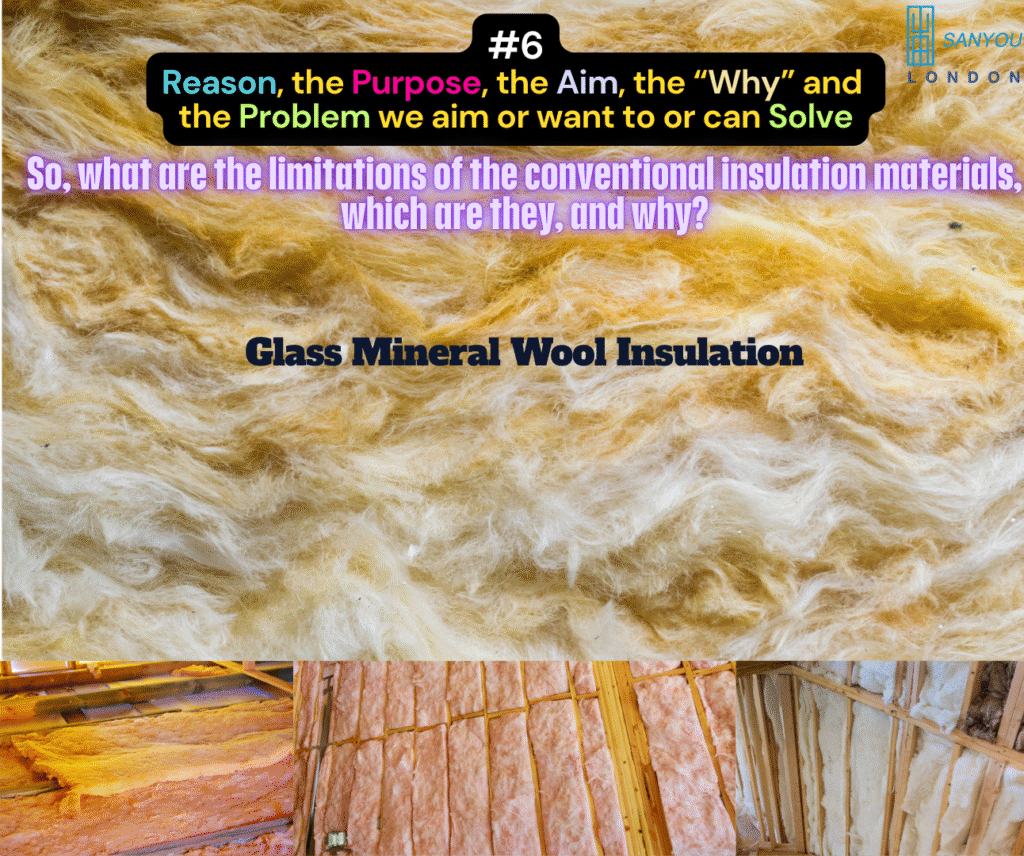
What are the limits of conventional insulation—and why do they matter?
Let’s be decisive. Conventional insulations are not “bad”; they simply carry constraints that become critical when you care about fire class, long-term performance, available depth, workmanship, or heritage settings. Below is a plain-English audit—then a practical route to higher performance with vacuum insulation where it makes sense.
EPS (Expanded Polystyrene)

What it is: A thermoplastic foam (polystyrene) used since 1949; light, cheap, easy to cut.
Typical thermal performance: λ ≈ 0.031–0.038 W·m⁻¹·K⁻¹ (product-dependent).
Fire behaviour: Commonly Euroclass E to EN 13501-1 unless protected within a tested system. It is combustible; under flame it softens, melts and can drip, sustaining fire spread unless robustly encapsulated.
Key limitations (and why):
- Combustibility risk. Even with fire-retardant additives, EPS remains thermoplastic; retardants slow ignition, they do not make it non-combustible.
- Thickness penalty. To reach low U-values, EPS usually needs substantial thickness, nibbling net floor area and complicating reveals.
- Ageing & exposure. Sensitive to solvents, UV (surface chalking), and thermal movement; long-term moisture uptake at joints can worsen lambda.
- Biology & hygiene. Open joints and cavities can harbour insects; dust and fungi may colonise damp interfaces.
- Refurbishment burden. In higher-value assets, the replacement cycle and façade fire compliance can make EPS a false economy.
Use only if: budget is the priority, fire class requirements are modest, and you can provide tested, continuous protection and adequate depth.
XPS (Extruded Polystyrene) — brief note
Thermoplastic cousin of EPS with tighter cell structure; λ often 0.029–0.036 W·m⁻¹·K⁻¹. Better water resistance than EPS, still combustible, and still needs depth for top performance. Similar caveats on fire and long-term protection.
PIR (Polyisocyanurate) boards

What it is: A thermoset polyurethane-family foam with closed cells; usually foil-faced.
Typical thermal performance: λ ≈ 0.022–0.026 W·m⁻¹·K⁻¹ (stronger than EPS/XPS).
Fire behaviour: Often supplied within systems achieving Euroclass B-s2,d0 / C-s2,d0 (product-specific). PIR chars rather than melts, but it is still combustible; smoke and toxic gases under full fire must be considered.
Key limitations (and why):
- Combustibility and facings. Foil facings help, yet panel joints, fixings and penetrations are where systems are tested—and where real sites can deviate.
- Thickness still matters. Better lambda reduces thickness, but achieving very low U-values still takes notable depth at façades and roofs.
- Ageing & moisture at edges. Closed cells resist bulk water; edge joints, facings and adhesives are the weak links; thermal ageing of blowing agents can nudge lambda upward.
- Dimensional stability. Temperature swings can bow large boards; gaps and compression lead to thermal bypass.
- Handling & dust. Site cutting generates dust; edge damage opens a path for moisture and air.
Use only if: you can control detailing rigorously, depth is acceptable, and the fire strategy tolerates combustible insulation within the tested build-up.
Rock mineral wool (stone wool)

What it is: Non-combustible fibres spun from rock; batts or slabs; often A1/A2.
Typical thermal performance: λ ≈ 0.034–0.040 W·m⁻¹·K⁻¹.
Fire behaviour: Commonly Euroclass A1 (non-combustible). Strong acoustic absorption.
Key limitations (and why):
- Depth requirement. To hit low U-values you often need thick layers, affecting façade lines and reveals.
- Wind-washing & convection. In ventilated cavities and roof spaces, air movement around fibres can erode performance unless wind barriers and airtight layers are excellent.
- Moisture and hygiene. Fibrous, vapour-open structure is tolerant of transient moisture, but persistent humidity or water tracking at cold bridges degrades lambda and can harbour dust and spores; smell and IAQ complaints follow.
- Settlement and gaps. Poor fit around services or slumping over time creates voids; thermal imaging often shows striped cold patches years later.
- Installation variability. Cut accuracy and compression under fixings change actual performance vs the brochure.
Use only if: fire class A1 is the primary driver and you can afford depth plus excellent air- and vapour-control layers.
Glass mineral wool

What it is: Glass fibres bound into quilts or batts; widely used; often A1/A2.
Typical thermal performance: λ ≈ 0.032–0.040 W·m⁻¹·K⁻¹.
Fire behaviour: Commonly Euroclass A1 (non-combustible).
Key limitations (and why):
- Depth & compression. Needs thickness; if squeezed into tight voids the effective lambda worsens and convection paths appear.
- Moisture uptake at cold spots. While not hygroscopic in the strict sense, fibres can hold moisture from interstitial condensation, raising lambda until dried.
- Dust & fibres. Can shed irritant fibres during install; poor vapour control invites bio-growth on neighbouring materials.
- Thermal bypass & air paths. Gaps at joists, studs and services allow airflow around the insulation, cutting real-world R-value.
- Maintenance reality. In ceilings and plant rooms, later trades often disturb quilts; performance drifts from day one.
Use only if: you can deliver airtightness, vapour control, wind protection and maintain thickness continuously.
Cross-cutting issues the brochure rarely mentions
- Space loss. Thick layers steal internal area and create awkward reveal details; buyers notice.
- Workmanship risk. Most failures are gaps, crushing, wetting, and thermal bridges; on-site reality rarely matches test rigs.
- Whole-life cost. Replacement, mould remediation, leak tracing, and compliance upgrades can dwarf the initial saving of a “cheap” insulation.
- Regulatory drift. Fire and energy regulations tighten; combustible insulations in façades require ever stricter system evidence.
- Overheating. Summer performance suffers when depth is trimmed to save space; thin but higher-R alternatives matter as climates warm.
When vacuum insulation is the pragmatic upgrade
Vacuum Insulation Panels (VIPs) and systems built around them remove gas conduction and convection, leaving only minimal solid conduction and controlled radiation—hence very low λ at millimetre scale.
What this buys you:
- Performance in thin build-ups. Meet tough U-values without sacrificing floor area or window proportions.
- Cleaner detailing. Slim profiles reduce clumsy soffits and deep reveals; easier heritage fit.
- Fire-class options. Decorative Integrated Vacuum Panels (DVIP) are available in A1-capable configurations with an architectural face.
- Targeted fixes. Vacuum Insulated Wallpaper (VIW) treats cold internal walls in ≈4 mm; Vacuum Insulated Curtains (VIC) address the glazing line without touching the window; VIHC adds gentle radiant warmth at low power where evening comfort is valued.
Design truths to accept up front:
- Protection is non-negotiable. VIPs must be guarded from puncture; cassettes/skins and planned fix points are part of the specification.
- Edges and joints matter. Maintain continuity; design returns and socket strategies.
- Cost vs outcome. Per square metre, VIP systems cost more than basic foams—but often less than thick façade rebuilds, lost floor area, and years of higher OPEX.
A quick chooser (order-of-magnitude guidance)
| Goal | EPS/XPS | PIR | Rock/Glass Wool | Vacuum solutions |
|---|---|---|---|---|
| Lowest cost upfront | ★★★ | ★★☆ | ★★☆ | ☆☆☆ |
| Thinnest for U-value | ☆☆ | ★★☆ | ☆☆ | ★★★ |
| Non-combustible | ☆ | ☆ | ★★★ (A1/A2) | ★★★ (DVIP options) |
| Moisture robustness | ☆☆ | ★★☆ (edges) | ★★☆ (with VCL) | ★★★ (sealed core + correct skins) |
| Workmanship tolerance | ☆☆ | ★★☆ | ☆☆ | ★★☆ (if detailed) |
| Heritage/space constrained | ☆ | ★★ | ☆ | ★★★ |
(★ = poor → ★★★ = strong; project-specific verification required.)
Practical next steps
- Define the constraint first: fire class, space, programme, heritage, or lifecycle OPEX.
- If depth is cheap and fire class allows: a robust mineral wool build with excellent air- and vapour-control can be right.
- If depth or fire class is tight—or aesthetics matter: specify DVIP externally; use VIP where space is restricted; apply VIW/VIC internally for fast wins.
- Write the details, not just the headline: joints, returns, fix points, and protection. That is where performance is won or lost.
Speak with us before you finalise the spec
- Contact our Customer Service Team for product data, build-ups, CAD details, and budget pricing aligned to your programme.
- Prefer a direct discussion? Email or phone Professor Saim Memon to review your drawings, fire strategy, and a whole-life cost comparison.
- Explore full specifications, purchasing steps, videos, and FAQs at www.sanyoulondon.com.
Bottom line: Conventional insulations still have a place—but their limits are real. Where fire class, space, or long-term reliability are non-negotiable, vacuum insulation is often the cleaner, safer, thinner answer.
Share

Author
Prof. Dr. Saim Memon
PhD, CEng, FHEA, MSc, BEng(Hons), PGC-TQFE, GTCS, MCMI, MIET, MIEEE, MInstP, IBPSA, APCBEES, MPEC
CEO | Industrial Professor | Inventor | British Scientist | Chartered Engineer | Qualified Teacher | Chief Editor | World Speaker | Pioneer in Vacuum Insulation Energy Technologies

